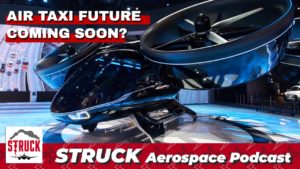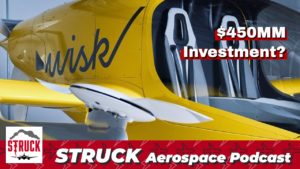The Otto Aviation Celera 500L makes some big fuel-efficiency and operation cost claims. It can glide 125 miles from 30,000 feet, but can it deliver on these promises? We discuss a jetpack incident at LAX airport, the potential of a supersonic Air Force One, Hyundai’s entrance into the EVTOL market, Gogo’s sale to Intelsat, and Tesla battery technology that could change the aviation industry forever.
Learn more about Weather Guard StrikeTape segmented lightning diverter strips. Follow the show on YouTube, Twitter, Linkedin and visit us on the web. Have a question we can answer on the show? Email us!
Podcast: Play in new window | Download
EP25 Transcript – Can the Otto Aviation Celera 500L Deliver on Efficiency Promises?
All right, welcome back. This is the struc podcast episode 25. I’m your cohost, Dan blewett and I’m here. Joined remotely by lightning protection expert. Allen hall, Allen, how are you? Great, Dan. Hey, uh, just reading the information about that auto, uh, aircraft design kinda looks like a fish with a propeller on the back.
That’s a pretty cool thing. New technology, sort of old technology combination between the two. Super dynamic. Yeah. We’ve got some interesting things to cover today. So with our, some of our news stuff, um, there was a man in a jet pack reportedly near LA lax airport. So that’s terrifying. So we’ll talk a little bit about that.
Uh, Gogo has been sold to Intel set, so some movement in the radon because radon business, uh, we are going to talk about the auto aviation. Uh, they have a bullet shaped plane, which. That’s some really interesting specs. I mean, it can glide up to 125 miles. They said. So the fuel efficiency is they’re proposing is tremendous.
Um, and lastly, we’ll also chat a little bit about, uh, potential for a supersonic air force, one, a Hyundai entering the EBTL market. And some battery advances by Tesla that might make a real big difference also in the electric aviation. So first let’s talk about this jet pack fellow. Uh, what is your take here?
I, I saw this article. That they’re investigating that there might’ve been a guy very close to the airport, which is obviously big cause for concern. Um, I mean, how do they regulate this stuff at the airport? Can’t fly anything near an airport because an aircraft might run into it. So they’re super cautious.
Pilots are very aware of, of periphery peripheral things around the airport that could pose a safety risk to the aircraft. So, uh, seeing, uh, somebody in a jet pack suit or something of the sort, probably set off a lot of alarm bells in the cockpit and, uh, because. The sh he shouldn’t be doing that, but I don’t think they have found who, who, what, when, where this thing is like this, this is still sort of a mystery.
As far as I can tell from the news sources, they haven’t identified who was doing this. And is it, it wasn’t a real person. Was it a dummy? Was it a drone of some sort who knows? Right. It could have been a high school kid with. So, you know, some sort of who, obviously they’re not the kids aren’t really at school right now looking to, you know, entertain themselves who knows.
Uh, but it is a real safety risk. Holy moly. Well, just, I mean, we were talking about bird strikes last from last week. Yeah. We’ll we’ll we don’t need to have his human strikes with people. Just stop there. And I mean, that’s horrific, so yikes. Yeah. They got to stay, stay away from the airport, right? Yeah. And are the, you know, the iron man movies have.
Uh, have a creative influence on a lot of, uh, people who are sort of quasi scientific and have the skill sets to, to make stuff. Right. So in today’s world, it’s not very hard to, to buy little jet engines that can propel you that have more thrust. Um, then your body weight and so they can lift you up. And, um, the guys off of, uh, MythBusters, do you ever see that episode or the one of the MythBusters guys built that iron man suit and was flying around in it?
That’s the first thing that popped in my head is that a myth Buster sky who was doing that. Um, but if you remember back in the old jeans, Bond movies, where they had James Bond in that jet pack flying around. And part of the movie that that’s what also popped to mind is like Holy moly or someone jet packs are a thing.
It is a thing that is not difficult to do in today’s world. You just don’t want to do it near an airport. That’s all. Man. Yeah, that’s a really, really bad idea. Get hit by a plane. Come on. Yeah. I mean, I think jet pack technology has enough trouble dealing with hitting the ground. I mean, that seems to be the main hazard.
Like let’s not throw extra variables yet. The ground is a major threat and we have planes coming at you. I mean, that’s a scary technology, but yeah. Yeah. So Intel set is, has acquired Gogo commercial. So you’re obviously super familiar with both of these companies, um, being in the radon protection business.
So what does this, uh, how does this, this transaction strike you? So $400 million was the sales price. Now Intel sat file for chapter 11, bankruptcy in may. Um, and they’re going to finance the transaction using cash on hand and some borrowing, but yeah. Um, what do you, what do you see emerging from this? Uh, the steel probably, uh, definitely more stable leftover Gogo, uh, the business side of Gogo, which is the air to ground side.
Not. Air in the aircraft, a satellite business. So they are the commercial sides, the aircraft to satellite, uh, to K U a pizza pie, shaped antennas with the rate them on the backend of the fuselage, uh, design. That’s a great product by the way. Uh, that seems to have really, they have really pushed that product pretty hard and have.
Deeply penetrated the marketplace with that product line. Uh, and rightly so, but it is, it is K U so that the, the bandwidth of that system is limited versus the Kia systems, the neuro case systems that are coming about today, but Gogo has been in some financial flux and they S it’s sort of, um, it’s a tough business to be in because you’re, you’re.
Selling these kits to install an aircraft and then getting some revenue back on the sales of the data. I think that’s how it’s all set up. Um, so. It’s sort of hand to mouth. Um, it takes a lot of cash to create that business. And then, and then you try and recoup it sort of slowly over time. And, and go, go on that, on that side of the business has had struggled.
In fact, it wasn’t probably a year or two ago where you’re talking about essentially the same thing, trying to break the company and to keep the business, the business side, business aircraft side up and running and soft, the commercial side to spacecraft. Manufacturer or spacecraft business, satellite business, uh, to them because it’s part of their network that would make sense to me.
The business side has always been very profitable for Gogo, so they have, uh, a number of air to ground. And there was a really there an evolution of other companies, but essentially they’ve always had this sort of network of cell towers they’ve installed antennas on to, uh, for the aircraft to. Uh, send data up and down to ground stations.
So as you fly across United States, you come across these ground stations that it send data up and down. So it was a sort of a cellular based technology, so to speak. So you put a couple of antennas, you have a transmit and receive and tone on the bottom of the airplanes. And, uh, you have decent data rates doing that.
There’s not a hundred people in a, in a global express or gold string, five there’s, five or six typically. So you don’t have to have a ton of data. And those towers and the air to ground system was sort of the right mix for that marketplace. Plus, you’re dealing with, uh, a sort of a, a class of ownership there on which the Casa system is sort of irrelevant because the desire to have internet and data and communication, if you’re a CEO of, um, you know, like Bloomberg or someone like that, you want to have that data.
So whatever you’re paying from it. Pretty much doesn’t matter to you because in the scheme of the wealth of that, or like a Zuckerberg or something like that, it doesn’t make any difference. Right. So, so it’s a much more profitable business market then sort of charging me eight bucks a to, for wifi on Delta or something.
That’s a different, totally different marketplace. So. As the airlines have been pushing for cost savings, obviously go gets Bush and go, go had a couple of issues, technical issues that really set them back, uh, particularly with Delta and that costs and some time and some money. So the Gogo has been letting go of people, um, in the last couple of months, partly due to COVID partly due to some other business issues, but that hasn’t been good because those, the engineers, they are at Gogo or.
Bright brilliant people. I mean, the ones I’ve dealt with have been really smart, um, and doing a fantastic job for the product. And some of them have been let go just because of economic conditions. Aren’t right. So I hope that now that they’ve transferred ownership to it. Satellite company that some of those engineers, you could hire back to support that product line, because it does have a marketplace and have a large market share right now.
And a you’d hate to see it go away. That that’s, it’s sort of like global Eagle global Eagle went through the same. It’s going through the same thing they filed for bankruptcy. A couple of months ago, global Eagle is the, uh, row 44 was the company that installed all the SOUTHCOMs on Southwest airlines, airplanes.
So everybody’s running. As soon as the airplane stopped flying the revenue streams from those aircraft stopped too. So if you’re relying upon the consumer revenue to pay for all the things you spent money on, all the engineering time and development time and airplanes, aren’t flying. You’re in trouble.
I’d be like, if you shut down 80% of the slot machine scenes in Vegas, like Vegas will be in big trouble. Right. You need people pulling the lever. Right. And they don’t have it right now. And so it’s. It’s causing a lot of chaos in the marketplace. What worries me is when we come out of this COVID-19 thing, is that all of a sudden internet service.
So I was traveling this last week a little bit, and one of the things I noticed, um, for the first time ever, actually I was having trouble with my, uh, global Eagle, Southwest airlines, internet connection. Like funky things were happening there. And then there’s never happened before I thought, is this a result of them being sort of financial difficulty, trying to reestablish itself as a company and they have technical issues, they don’t have the staff to support it, or is it just a fluke, but you know what runs through your mind?
It’s like, Hey, they’re in bankruptcy. The reorganizing stuff happens when you’re reorganizing. And this kind of, um, from the consumer perspective, chaos happens. But it’s not good. You know, we’ve, we’ve got to get back to people starting to travel again relatively soon.
All right. So in our engineering segment, we’re going to chat about. Uh, first off the auto aviation Celera 500 L, which their company’s calling the most fuel efficient commercially viable passenger aircraft in the world. Now, if you were to, if you were going to go back to elementary school and draw a fish where you make like the big loop and then you make the tail.
That’s essentially what his aircraft looks like. Um, and so it does look strikingly different. It looks kind of like a blimp. It’s got a, you know, a rear pusher propeller. It’s got some really long thin, um, then wings, but all these things obviously have a very silly purpose. They say extensively utilizes laminar flow over the fuselage wing and tail.
And that it can glide 125 miles at 30,000 feet. So obviously with all this glide, you know, the ability to glide so far, it’s extremely. Fuel efficient. So Alan, you say this is almost like a rebirth of a previous jet, is that true? Well, if anybody remembers the Leer fan and the Lear fan was, uh, bill Lear late in his life, um, bill Lear was building an aircraft out in Kansas.
I think it was Kansas. It was a composite airplane and it looked very similar list. It had a kind of a fish shape, fuselage propeller on the back and not as highly, uh, laminar flow wing at the time, just because he didn’t have the computers to do that stuff. But it had two engines. Uh, kind of turbo prop engines that were driving, I think a total prop.
And did you ever driving through a transmission, a single propeller in the back. And just the era in which that was being developed, it had difficulty with the transmission had difficulty and they were making out of carbon fiber, which was really new at that point that’s before the, the beat star ship even came out.
So the beast Starship was sort of an outgrowth of the Lyrica and all the engineers that are around the Lear fan kind of jumped over to beach at the time and to make the Starship and then make the, the premier and the horizon and everything else after that. Um, but. The aerodynamic design has been a concept for a while.
So it’s not like this auto aviation is a necessarily a new idea as much as they have now the computational power to do the laminar flow thing and to make it super slippery, to be very efficient, which biller didn’t have during his lifetime. So it’s sort of a combination of old, old school sort of, uh, uh, basic fundamental design, right?
You want two engines so he can fly and keep the propeller turning, but you want all their dynamic efficiency that you can get because you have the computers to go do it. That’s what it looks like to me. Um, so it doesn’t look, and I know the thing about here’s the thing about aircraft shape. I always find fascinating is there is a little bit of human psychology into the way that they sign those aircraft.
That. When you’re putting down the amount of money to buy an airplane, some part of that is a cool factor and it looks cool. Piaggio has been in this marketplace for awhile. Uh, Piaggio has a very similar shaped aircraft. It’s a pusher plan also, and it has that kind of cool factor to it. And it’s Italian and it’s got all these things.
So. Wait, are you saying this one does have cool factor? It does not have it. I don’t know if this thing has cool factor. It doesn’t look sometimes it’s by sometimes by paint. And so here’s the thing that I noticed first off, it just painted all white. Right. Yeah. Right. And yeah, if, if I’m, if I’m a marketing guy or marketing person, then the be a guy can be anybody.
If I’m a marketing person at a new aircraft company, I want my aircraft to be the coolest look and thing that anybody has ever seen. I want the thing to look like a. Formula one race car. That’s what I’m going for. And right now it looks like a bloated fish, a little bit, which is not particularly appealing to the eye.
It is very efficient, aerodynamic. It’s very efficient, but they got to find a way to make it look. Cool also. Yeah, like a two, two. And that’s what I was just when you said cool factor. I immediately thought of the Honda jet, which those are very impressive looking, paint, very impressive shaped, but they also have impressive paint shops to where you’re right.
If you, if you can. And of course, a lot of these are like, this is going to be more like a business jet where they say it could be economically almost the same price as a fly on a commercial jet, which is crazy to think about that. You could have a similar cost, you know, we’ll see. But. Uh, you know, if, if you’re some rich dude or some rich gal and you want to buy and you’re going to have like your first, you’re going to buy your first.
Yeah. And you’re like, they’re both $15 million or, and I don’t know if that’s the price, I’m just throwing a price out there. I have $15 million to spend. And they’re both pretty comparable, but uh, I want this to reflect on how important I am and cool. I am like you said, so. Yeah, I think, I think there’s definitely something to be said there.
You don’t want to be the guy with the dorky. You don’t want to have the minivan of, of the airplane world, right? You don’t like, it’s not what you want. That’s not what you want. So just like a Tesla, right? A Tesla car is a car, you know, it’s got four wheels, it’s got the, windshield’s got the steering wheel, it’s got the whole thing, but you know, they’ve trimmed all the.
Door handles down. They’ve it doesn’t have an antenna on it. It’s got it’s aerodynamically. It’s got all these a little funky, little, very, uh, a lot of finesse and marketing decisions were made about the design and look of the car and the colors they have chosen by the way to make it look cool and inviting because the car costs twice, what a normal piston gasoline powered car would cost.
So you gotta make it worth their while a little bit. And that’s, that’s part of the way they do it. Yeah. And they really departed, I mean, Tesla from the, just horrifically ugly, you know, um, what is it though? The Honda, uh, what was it? I’m drawing a blank, but I mean, some of the early electric cars are just so bad looking, you know, the Prius, the Toyota Prius is like the ugliest car of all time.
I mean, come on. Like why? Just because it was electric, we had to shape it like that. I think again, and the Prius was, was an aerodynamic Leigh shaped vehicle. To keep the fuel efficiency high, just like the auto aviation aircraft is right. But you have to make an, I think that was one of toy design issues and that they never could make it cool.
They made it environmentally cool. It was a sort of a status symbol thing, which is a way to market it and sure. Uh, but aircraft are different than that because they’re not seen as green or copper, never really seen as green. So you’re in a different sort of marketplace where the cool factor, and this is where bill Lee or Learjet had this figured out years ago, which is it’s got to look cool as gotta be around, uh, influencers and.
Be adapted, adopted in sort of that. And that’s Gulfstreams on the same thing. And the Bombardia global express people have done the same thing where they’re trying to make the aircraft part of lifestyle. And that part of aircraft sales is sometimes overlooked, particularly by the engineers who. You know, are not going to be able to ever buy one of these things in our lifetime.
So the engineers just want to make sure, right. But the, the, the marketing groups want to sell them. And those are two different animals that doesn’t always meet. So whenever I see a prototype aircraft yeah. That doesn’t have a cool paint job. I don’t, I think, Oh, you just missed a really great opportunity to put yourself out front.
Yeah. Yeah. Well, speaking of super cool. Uh, the U S air force has issued contracts for a supersonic air force one. So. X Sonic XO Sonic and Hermia, uh, which are, I guess like not super well known, might not household names are not Boeing, right? They’re not they’re buzz. Right? They’re not Lockheed Martin. So, um, but they’re awarded separate contracts by the air force, uh, to potentially develop this supersonic plane.
What is a, you know, a Mach 1.8 twin jet is kind of like the idea, but. Is this viable? I mean, does this seem like crazy? I mean, not just saying this is going to happen in 10, 20 years. How, how, how far out of the distance is it probably 20. Well, it’s really far. Sorry, Donald, you won’t be in this plane. Sorry.
Yeah. Uh, just because, well, I think about it. I mean, we’ve, we’ve been building aircraft that have passed the Mach one threshold for a long time now, so that’s not new technology. So there’s a couple like boom and Arion and a couple others are going to build a supersonic business aircraft. That’s that’s.
In the works when they were building prototypes right now. So that, that that’s happening. I think the air force, one’s a different animal in that it’s got to have a ton of communications equipment. It’s got to have ability to hold a lot of people because there’s always press, there’s press as part of the.
President’s job is communication, right? So there’s always press and staff and things and, and air force personnel and safety personnel on it. And it has to be super, super safe. This the thing about a seven 47, which has been used for. Most of my well, a long time now, since the seventies, I think as the, well, since no, since Reagan, since Reagan, which had been the eighties is when I think the seven 47 air force one popped out, it was, it was just a four engine aircraft.
And it’s specially designed to fly super high altitudes and has all this anti missile technology. How does a satellite communication technology on it? I don’t know how you’re going to do that on a supersonic aircraft because they don’t tend to be big. Like, where does all the stuff come in and how do you make it go super Sonic without having all these defensive mechanisms and, um, communications equipment and ability to, you know, there’s, there’s some fundamental parts of this, which we’ll have to try to figure out which why I say it’s going to be a 20 year event because they will not, the air force will not let the president get anywhere near this thing until they are guaranteed that this has no chance of coming out of the air.
Ever ever an the air force has never had an air force one accident, hasn’t it. Right. And it was just because that aircraft is maintained at such a high level and there’s two of them, but those aircraft are maintained such a high level all the time. A supersonic aircraft in the air force deals with those are supersonic aircraft all the time.
All the fighter jets are. But, you know, there’s yeah. Accidents and those aircraft all the time is seven 47 is don’t come out of the air too often. So there’s, there’s that reliability factor. I think that has to be built into any sort of supersonic air force one. I get the concept where the president’s not any tied up, um, on an aircraft for a six hour flight when she can do an, a one there’s a lot of upside on that.
If you’re the president, cause your time is extremely valuable, but. I just don’t see it. It’s cool. It’s a great, cool idea. And maybe they’ll develop some technologies to make all this happen, but there’s a lot more than just the aircraft here. A lot more. Yeah. I hadn’t thought about that, but you’re right.
I mean, you talk about the difficulties of certification just in general. And now you’re saying this has got to be president. Certified, which is like a whole nother thing. That’s an interesting thought. Yeah. I didn’t think about that, but for sure, there’s going to be a lot more hoops and bells and whistles they’ll have to have installed.
So to make that work. Oh, yes. To say, to say the least. Yeah.
all right. So let’s jump into our electric tech segment. Uh, we’ve got some interesting EBTL news. So Alan Hyundai, uh, they’re joining, we needed more people. You’d always didn’t have enough already trying to capture the EBTL market. Um, and this is a really cool looking, I think it’s really cool. It looks very futuristic.
Uh, they’re partnering with, uh, Uber elevate to help develop these air taxis. So Hyundai is partnering with them. And, uh, their, their essay one will potentially cruise at 180 miles per hour between one to 2000 feet of elevation with a range of about 60 miles. Um, this thing, and I only see this one photo, it looks like it has propellors on top and bottom of these big extensions, like off the two kind of like main wings.
Yep. I mean, we’ve talked about safety of what, what happens if one of the propeller blades breaks off and I’m looking at, how do you get in this plane without having your head hit the rotor? Yeah. Like, I don’t know. That seems, that seems awfully close to where the people go for the again. Yeah. It’s a cool factor.
There are a lot of this marketing of the EBTL marketplace is based on coolness and there. They’re smart. And it, particularly when you have automotive companies involved, because they understand what the consumer market looks like all the time, because they’re constantly in it. And they know them. They’re surveying people all the time.
They’re watching trends and watching particularly color, trend, shape trends, all that stuff. And then the car market is an output of whatever, all the other. Marketplaces that we’re in and try. I always feel a lot of times, particularly the United States automakers are always sort of falling behind on trends.
They’re watching, they’re watching. So the, the EBTL V E V T O L market has really cool looking stuff on computer generated and they paint and they paint their prototypes to look cool, like a final design, which is smart. And there’s some marketing people involved in that really, really smart, but. I think we need to get past the, is it shiny and look cool to, um, putting a human being in it?
And if something were to go wrong to people, walk away from it. That’s a harder question to answer and which is going to take a lot more engineering time to figure out. So you, what you don’t want to. Get too deep into is having a marketing to purse, marketing team define the final configuration. Um, and then you can’t certify it.
Can’t make it work. So have you ever seen a movie Tucker about, um, Building the car building, the helicopter engine car and the rear and, and, uh, back of the F after world war II. So it was like late forties, early fifties. So that sort of thing happened to them where they had this. He was, he Tucker was selling that.
Picture of a car and he sold a lot of them quite actually. So a lot of cars based on a photo or an image or a drawing of this thing. Yeah. And then when the engineers got of all like, Hey, we can’t do that. Hey, you know, we’ve got an air cooled engine. We need to have all this stuff. Right. So we have a, you have to have, you have to make it into a product at some point.
And when you sell an image, it’s hard and you get people locked into that. It’s hard to, for engineers to change that. Yeah, it’s really difficult. It’s a, that you don’t want to claw claw back that here, here, here’s what this beautiful electric is going to be. And then you deliver and you’re like, Oh, it’s actually way different looking.
And not nearly as aesthetically appealing and not what you thought it was. So then you gotta, you have to fit the fit, the engineering into this box that may be just may not fit. Right. You have, how much have you noticed lately that they’ve all got to wait? So all the ducted fans designs have gone away.
Right. So then you said this long tube around the blade. Yeah. That’s gone away because you don’t work. Yeah. You know, their dynamics don’t work on that. And in particular flight configurations, as you tilt those things, you don’t have their dynamics. You want to fly it. So it may be more kind of small little plastic drone in my backyard, but it sure isn’t going to work on a, you know, 5,000 pound vehicle.
Not happening. So it’s when you, when we see these things, especially when you have automotive companies get involved, you know, you hope that they bring along sort of the, yeah, it’s got to look cool, but yeah, it also has to work part because they’d gone through that a lot and they archive companies. Don’t always do that.
That’s where there’s so many aircraft companies I think at fail is that they sold a thing, an image and idea concept. But the reality is you can’t make that work. That’s where. I don’t know w that’s where companies get made or fail a lot of kittens right there. I know when I worked on the, the beach premiere, right?
So the beach Vermeer jet was my opinion, really cool looking thing. Right. But I got people got sold a certain, certain look to it. And when it was finally produced, um, just because of the way that it was configured and the way that we wanted to manufacture it, it had long. Landing gear like the aircraft stood up high because the wing was actually bolted to the bottom of a real cylinder, a fuselage.
So usually the wing actually penetrates a cylinder of the fuselage in this case, it didn’t, it actually is bolted onto the bottom. So it’s kind of got this Guppy. Yup. You look to it and it looks odd on the ground. He had a hard time, I think marketing the thing because it looks cool and it was fast. Uh, and it did.
Performance wise, pretty much essentially what it was sold to, but the comments on the yeah. Internet where, Oh, it looks, it looks Guppy ish. It looks, it doesn’t have, but in flight is awesome. Yeah. It looks, it looks, have a lot to do with the aircraft market because just the marketplace you’re in. It really is.
Yeah. And it’s a high dollar thing. Like, like we said, it’s got to look, it’s got to look the part. Yes, which is what Honda done. Right. And Honda has totally done that with the Honda jet. Yeah. They started out with a cool design, but they also knew that it would work and they stuck to it. So they did spend a lot of time making those two things.
The coolness and the functionality worked together. They spell many, many years doing that. Now, of course, you know, it’s always, the dog is not barking. You always wondering where’s the dog is not barking. Who’s the dogs are barking. N E V T O L. Honda Honda. Isn’t barky right here. Where are they? Right there?
Cause I’m making a really cool or a craft. It has market appeal. It, they have decent sales in a thing already, so they know what they’re doing and they have, I know the automotive, uh, dry behind them to go. Do a next stage and they have not announced it yet and the EBTL market. And I really wonder if there’s something cooking down in North Carolina on E V T O L for Honda, because it would make sense.
And part of the urban mobility automotive growth out automotive, there are, I’ve been in the aircraft business. They already know what they’re doing when they’re there. They have all the engineers to certify stuff. They have a great electrical engineering department. So. They could totally go do it any VTL and I think be successful in it, but they have not made any noise in that marketplace.
And that’s the one to watch for. Hmm. Well, I mean, you go back to how to you convince people of anything and then there’s so much research about how people don’t just respond to facts. So facts, obviously in this case are like, here’s the speed of it? The aerodynamics here’s the range like here are all the tech specs, right?
Yeah. But when you see something like you see that beautiful Honda jet and you’re like, Ooh, I can see myself in that. And you start, you have like an emotional attachment is something that’s like a beautiful sports car, you know, beautiful airplane. And then like, that’s fine. But like this one, which you don’t feel that way about has like, Better specs it’s fast or you’re like, now this one makes me feel warm and fuzzy inside.
So I think you’re right. That there’s still, these are still humans buying these vehicles and you can’t just sell them a spec sheet. No, not today. No, definitely not at all. No. So last thing on our list today, Tesla, they say, uh, in their battery research, uh, they’re getting closer to a potential breakthrough that could really affect, uh, aviation.
So what’s your take? It sounds like the ease. I mean, obviously this is going to be. Big news for the EBTL market. Um, they have an anode free lithium metal battery that Tesla, our research team in Canada is. They say, they’re getting to this approximately 360 watt hour per kilogram energy density that they need to potentially power these aircraft a lot better.
So, um, how big of a deal is this? Well, have you bought Tesla stock lately, Dan? Because you probably should. That’s how big of a deal it’s going to be a Tesla stock in my opinion is extremely overvalued. And Elon Musk will tell you that today, like. It doesn’t make any sense, but he does that all the time anyway.
Yeah. It doesn’t make any sense. Right. Uh, it’s a cool factor and there’s a lot of cash in the marketplace because the economy’s down. So things that look like that are, are positively moving forward. Get a lot of cash, jump into them. And Tesla has been that. Now there’s been a lot of talk for several months about Tessa announcing a bet new battery technology.
And it seems like it gotten delayed a little bit and delayed a bit. Now the latest I heard is going to be the middle to end of September is when they’re going to make a formal announcement. At least MUSC has been tweeting about it a little bit. I think that will happen. And if the energy, essentially energy, energy density of the batteries makes some.
Significant breakthrough, even though moderate breakthrough would be a really big on all kinds of battery technology things. So, you know, mosque has got so many things cooking at one time Tusla and space X, and it’s not just mosque, right? I mean, there’s, there’s. Thousands of engineers and tens of thousands and employees at those companies that are, that are making, uh, magical things happen right now.
But. You know, MUSC is really pushing towards really a different looking society as some sort of, that seems to be where he’s going with the Mars people living on Mars and trying to get people to chill out on Mars. I think that is a possibility still, it’s still in the realm of stability, but he’s also making, can you inroads in significant battery technology?
Uh, that will have a real. Driving change into the way the American European Asian economies work. And don’t think otherwise, because if some of these things even come partly true, there’s going to be a big shift. And if we can drive the cost of battery down and get the density, energy density up a ULI will have a diff our kids will have a different life than what we had.
And I do think. The thing about mosque, is that, and just having seen a little bit closer to the last couple of weeks, I do think that there is a. Uh, kinda like Google had for awhile on Facebook had for a while. There’s sort of this gravitational effect on engineering talent. That’s, that’s happening with him where it’s like the top destination for engineering graduates.
Um, just because I think they’re just visible and they pay decent salaries and Brooklyn, all cool stuff. But the fallout of that is that you have a lot of smart people working pretty hard and seeing it and seem to have sort of a greater goal going on. So the willing to. Put in time on it to push the technology and mosque doesn’t seem to care where the technology is being developed at.
Thank you. So this is up in Canada, right? So he doesn’t care if there is an idea that holds merit. And I think they’ve spread out trying different things and trying to focus where the activity really is happening in put some energy into it and try to get over the finish line, his ability to. Create buzz is great because he’s got successful things that are working and it sort of gets us a little cyclical, well thing where engineering talents going to them market forces driving it.
There’s a lot of cash cash flow, so he can do things that other corporations could never do. And hopefully it’ll get us over this. Battery battery limitation has been going on for a hundred plus years. It will be a huge breakthrough that I know it’s hard to think about this, but it’ll it’ll change lives.
It really well. I mean, the having seen the Tesla factory recently, And the number of cars pumping out of that place. You’re like, Holy Molly, they are making a lot of cars. This is not just for the elite anymore. You see a lot of cars driven by people who, who, you know, five years ago probably wouldn’t thought about it.
So there’s a changing force in the marketplace and this battery technology is going to drive it forward in automotive and in aviation. No doubt. All right. Well, that’s it for today’s episode of struck, we covered a lot of really good topics today. Uh, if you’re new to the show, thanks for listening. Be sure to subscribe and check us out on Spotify, iTunes, Stitcher, YouTube, wherever you listen to podcasts and be sure to check out our website at weather guardaero.com. That’s aero.com where we have more articles, videos, all of our podcasts, tons of help docs. So if you’re. An engineer needed help when your random design or your lightning protection systems. Definitely check out our website or reach out to us again at weather guard, arrow.com. Thanks again, and we’ll see you here on the next show.












